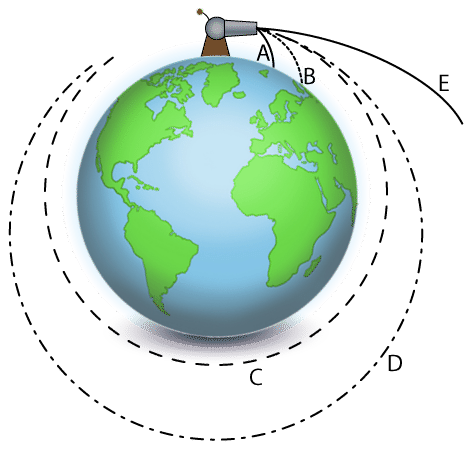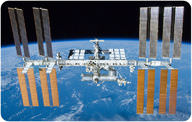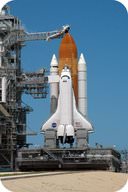2.15: Satellites, Shuttles, and Space Stations
- Page ID
- 5336
\( \newcommand{\vecs}[1]{\overset { \scriptstyle \rightharpoonup} {\mathbf{#1}} } \)
\( \newcommand{\vecd}[1]{\overset{-\!-\!\rightharpoonup}{\vphantom{a}\smash {#1}}} \)
\( \newcommand{\id}{\mathrm{id}}\) \( \newcommand{\Span}{\mathrm{span}}\)
( \newcommand{\kernel}{\mathrm{null}\,}\) \( \newcommand{\range}{\mathrm{range}\,}\)
\( \newcommand{\RealPart}{\mathrm{Re}}\) \( \newcommand{\ImaginaryPart}{\mathrm{Im}}\)
\( \newcommand{\Argument}{\mathrm{Arg}}\) \( \newcommand{\norm}[1]{\| #1 \|}\)
\( \newcommand{\inner}[2]{\langle #1, #2 \rangle}\)
\( \newcommand{\Span}{\mathrm{span}}\)
\( \newcommand{\id}{\mathrm{id}}\)
\( \newcommand{\Span}{\mathrm{span}}\)
\( \newcommand{\kernel}{\mathrm{null}\,}\)
\( \newcommand{\range}{\mathrm{range}\,}\)
\( \newcommand{\RealPart}{\mathrm{Re}}\)
\( \newcommand{\ImaginaryPart}{\mathrm{Im}}\)
\( \newcommand{\Argument}{\mathrm{Arg}}\)
\( \newcommand{\norm}[1]{\| #1 \|}\)
\( \newcommand{\inner}[2]{\langle #1, #2 \rangle}\)
\( \newcommand{\Span}{\mathrm{span}}\) \( \newcommand{\AA}{\unicode[.8,0]{x212B}}\)
\( \newcommand{\vectorA}[1]{\vec{#1}} % arrow\)
\( \newcommand{\vectorAt}[1]{\vec{\text{#1}}} % arrow\)
\( \newcommand{\vectorB}[1]{\overset { \scriptstyle \rightharpoonup} {\mathbf{#1}} } \)
\( \newcommand{\vectorC}[1]{\textbf{#1}} \)
\( \newcommand{\vectorD}[1]{\overrightarrow{#1}} \)
\( \newcommand{\vectorDt}[1]{\overrightarrow{\text{#1}}} \)
\( \newcommand{\vectE}[1]{\overset{-\!-\!\rightharpoonup}{\vphantom{a}\smash{\mathbf {#1}}}} \)
\( \newcommand{\vecs}[1]{\overset { \scriptstyle \rightharpoonup} {\mathbf{#1}} } \)
\( \newcommand{\vecd}[1]{\overset{-\!-\!\rightharpoonup}{\vphantom{a}\smash {#1}}} \)
\(\newcommand{\avec}{\mathbf a}\) \(\newcommand{\bvec}{\mathbf b}\) \(\newcommand{\cvec}{\mathbf c}\) \(\newcommand{\dvec}{\mathbf d}\) \(\newcommand{\dtil}{\widetilde{\mathbf d}}\) \(\newcommand{\evec}{\mathbf e}\) \(\newcommand{\fvec}{\mathbf f}\) \(\newcommand{\nvec}{\mathbf n}\) \(\newcommand{\pvec}{\mathbf p}\) \(\newcommand{\qvec}{\mathbf q}\) \(\newcommand{\svec}{\mathbf s}\) \(\newcommand{\tvec}{\mathbf t}\) \(\newcommand{\uvec}{\mathbf u}\) \(\newcommand{\vvec}{\mathbf v}\) \(\newcommand{\wvec}{\mathbf w}\) \(\newcommand{\xvec}{\mathbf x}\) \(\newcommand{\yvec}{\mathbf y}\) \(\newcommand{\zvec}{\mathbf z}\) \(\newcommand{\rvec}{\mathbf r}\) \(\newcommand{\mvec}{\mathbf m}\) \(\newcommand{\zerovec}{\mathbf 0}\) \(\newcommand{\onevec}{\mathbf 1}\) \(\newcommand{\real}{\mathbb R}\) \(\newcommand{\twovec}[2]{\left[\begin{array}{r}#1 \\ #2 \end{array}\right]}\) \(\newcommand{\ctwovec}[2]{\left[\begin{array}{c}#1 \\ #2 \end{array}\right]}\) \(\newcommand{\threevec}[3]{\left[\begin{array}{r}#1 \\ #2 \\ #3 \end{array}\right]}\) \(\newcommand{\cthreevec}[3]{\left[\begin{array}{c}#1 \\ #2 \\ #3 \end{array}\right]}\) \(\newcommand{\fourvec}[4]{\left[\begin{array}{r}#1 \\ #2 \\ #3 \\ #4 \end{array}\right]}\) \(\newcommand{\cfourvec}[4]{\left[\begin{array}{c}#1 \\ #2 \\ #3 \\ #4 \end{array}\right]}\) \(\newcommand{\fivevec}[5]{\left[\begin{array}{r}#1 \\ #2 \\ #3 \\ #4 \\ #5 \\ \end{array}\right]}\) \(\newcommand{\cfivevec}[5]{\left[\begin{array}{c}#1 \\ #2 \\ #3 \\ #4 \\ #5 \\ \end{array}\right]}\) \(\newcommand{\mattwo}[4]{\left[\begin{array}{rr}#1 \amp #2 \\ #3 \amp #4 \\ \end{array}\right]}\) \(\newcommand{\laspan}[1]{\text{Span}\{#1\}}\) \(\newcommand{\bcal}{\cal B}\) \(\newcommand{\ccal}{\cal C}\) \(\newcommand{\scal}{\cal S}\) \(\newcommand{\wcal}{\cal W}\) \(\newcommand{\ecal}{\cal E}\) \(\newcommand{\coords}[2]{\left\{#1\right\}_{#2}}\) \(\newcommand{\gray}[1]{\color{gray}{#1}}\) \(\newcommand{\lgray}[1]{\color{lightgray}{#1}}\) \(\newcommand{\rank}{\operatorname{rank}}\) \(\newcommand{\row}{\text{Row}}\) \(\newcommand{\col}{\text{Col}}\) \(\renewcommand{\row}{\text{Row}}\) \(\newcommand{\nul}{\text{Nul}}\) \(\newcommand{\var}{\text{Var}}\) \(\newcommand{\corr}{\text{corr}}\) \(\newcommand{\len}[1]{\left|#1\right|}\) \(\newcommand{\bbar}{\overline{\bvec}}\) \(\newcommand{\bhat}{\widehat{\bvec}}\) \(\newcommand{\bperp}{\bvec^\perp}\) \(\newcommand{\xhat}{\widehat{\xvec}}\) \(\newcommand{\vhat}{\widehat{\vvec}}\) \(\newcommand{\uhat}{\widehat{\uvec}}\) \(\newcommand{\what}{\widehat{\wvec}}\) \(\newcommand{\Sighat}{\widehat{\Sigma}}\) \(\newcommand{\lt}{<}\) \(\newcommand{\gt}{>}\) \(\newcommand{\amp}{&}\) \(\definecolor{fillinmathshade}{gray}{0.9}\)Why are satellites important?
In 1900, a category 4 hurricane devastated Galveston, Texas. It claimed the lives of between 6,000 and 12,000 people. By contrast, the death toll from Hurricane Katrina was about 1,800 people. Why the difference? Although Hurricane Katrina (and Harvey and Maria and others) was a modern tragedy, it would have been much worse without the advance warning of many weather satellites.
Rockets
Humans did not reach space until the second half of the 20th century. They needed to somehow break past Earth's gravity. A rocket moves rapidly in one direction. The device is propelled by particles flying out of it at high speed in the other direction.
How Rockets Work
Rockets were used for centuries in wars and for fireworks before anyone could explain how they worked. In 1687 Sir Isaac Newton developed his Laws of Motion. The third law says: To every action there is an equal and opposite reaction. In other words, when a rocket's propulsion pushes in one direction, the rocket moves in the opposite direction (Figure below).
A rocket pushes in one direction so that it moves in the opposite direction.
For a long time, many people believed that a rocket wouldn’t work in space. There would be nothing for the rocket to push against. But they do work! Fuel is ignited in a chamber. The gases in the chamber explode. The explosion creates pressure that forces the gases out of one side of the rocket. The rocket moves in the opposite direction (Figure below). The force pushing the rocket is called thrust.
This Space Shuttle launch shows how the thrust of the rocket pushes the shuttle upward into the sky.
A Rocket Revolution
For centuries, rockets were powered by gunpowder or other solid fuels. These rockets could travel only short distances. Around the turn of the 20th century, liquid fuel rockets were developed. Liquid fuel gave the rockets enough power to escape Earth’s gravity. By using multiple stages, empty fuel containers could drop away. This reduced the mass of the rocket so that it could fly higher.
Satellites
One of the first uses of rockets in space was to launch satellites. A satellite is an object that orbits a larger object. An orbit is a circular or elliptical path around an object. Natural objects in orbit are called natural satellites. The Moon is a natural satellite. Human-made objects in orbit are called artificial satellites.
How a Satellite Stays in Orbit
Newton’s law of universal gravitation describes how an object can orbit a planet. Every object in the Universe is attracted to every other object by gravity. Gravity also keeps you from floating away into the sky. Why doesn't gravity cause satellites to crash into Earth?
Newton used an example to explain how gravity makes orbiting possible. Imagine a cannonball launched from a high mountain (Figure below). If the cannonball is launched at a slow speed, it will fall back to Earth. This is shown as paths (A) and (B). If the cannonball is launched at a fast speed, Earth curves away at the same rate that the cannonball falls. The cannonball then goes into a circular orbit, as in path (C). If the cannonball is launched even faster, it could go into an elliptical orbit (D). It might even leave Earth’s gravity and go into space (E).
Isaac Newton explained how a cannonball fired from a high point with enough speed could orbit Earth.
Unfortunately, Newton’s idea would not work in real life. A cannonball launched at a fast speed from Mt. Everest would burn up in the atmosphere. However, a rocket can launch straight up, then steer into orbit. It won't burn up in the atmosphere. So a rocket can carry a satellite above the atmosphere and then release the satellite into orbit.
Satellite Orbits
Satellites have different views depending on their orbit. Satellites may be put in a low orbit. These satellites orbit from north to south over the poles. These satellites view a different part of Earth each time they circle. Imaging and weather satellites need this type of view.
Satellites may be placed so that they orbit at the same rate the Earth spins. The satellite then remains over the same location on the surface. Communications satellites are often placed in these orbits.
Types of Satellites
The first artificial satellite was launched just over 50 years ago. Thousands are now in orbit around Earth. Satellites also orbit the Moon, the Sun, Venus, Mars, Jupiter, and Saturn. Satellites have many different purposes. There are satellites for communications and navigation. There are satellites for taking pictures of a planet's surface.
Dozens of satellites collect data about Earth. NASA’s Landsat satellites make detailed images of Earth’s continents and coastal areas. Other satellites study the oceans, atmosphere, polar ice sheets, and other Earth systems. This data helps us to monitor climate change. Other long-term changes in the planet are also best seen from space. Satellite images help scientists understand how Earth’s systems affect one another. Different satellites monitor different wavelengths of energy.
Space Stations
Humans have a presence in space at the International Space Station (ISS) (Figure below). Modern space stations are constructed piece by piece to create a modular system. The primary purpose of the ISS is scientific research, especially in medicine, biology, and physics.
A photograph of the International Space Station was taken from the space shuttle Atlantis in June 2007.
Space Shuttles
Craft designed for human spaceflight, like the Apollo missions, were very successful. They were also very expensive and could not carry much cargo. They could be used only once. To outfit the ISS, NASA needed a space vehicle that was reusable. It needed to be able to carry large pieces of equipment. The cargo might include satellites, space telescopes, or sections of a space station. The resulting spacecraft is called a space shuttle (Figure below).
Atlantis on the launch pad in 2006. Since 1981, the space shuttle has been the United States’ primary vehicle for carrying people and large equipment into space.
A space shuttle has three main parts. The part you are probably most familiar with is the orbiter. The orbiter has wings like an airplane. When a space shuttle launches, the orbiter is attached to a huge fuel tank that contains liquid fuel. On the sides of the fuel tank are two large "booster rockets." All of this is needed to get the orbiter out of Earth’s atmosphere. Once in space, the orbiter can be used to release equipment (such as a satellite or supplies for the International Space Station). It can be used to repair existing equipment, such as the Hubble Space Telescope. Astronauts can even do experiments directly on board the orbiter.
When the mission is complete, the orbiter re-enters Earth’s atmosphere. The craft flies back to Earth more like a glider than an airplane. The Space Shuttle program did 135 missions between 1981 and 2011, when the remaining shuttles were retired. Since the space shuttles have retired, the ISS is serviced by Russian Soyuz spacecraft.
You can visit the retired shuttles around the country:
- Enterprise at the Intrepid Sea-Air-Space Museum, New York City.
- Discovery at the National Air and Space Museum, Chantilly Virginia.
- Atlantis at the Kennedy Space Center, Florida.
- Endeavour at the California Science Center, Los Angeles.
SpaceX
On May 30, 2020 NASA and SpaceX sent Robert Behnken and Douglas Hurley to the International Space Station from the Kennedy Space Center in Florida. These astronauts were testing SpaceX’s Falcon 9 rocket and Crew Dragon spacecraft on their ability to transport people to and from the International Space Station.

This illustration shows the Crew Dragon spacecraft in low Earth orbit.
This historic launch is the first commercially built spacecraft to take astronauts into Earth’s orbit. It is also the first time in the United States launched its astronauts from US soil since NASA’s Space Shuttle Program ended in 2011. Falcon 9 is also the first rocket that can send things into Earth’s orbit and then be reused for another flight.
These amazing firsts all contribute to NASA’s Commercial Crew Program which partners NASA with private companies to build space transport systems to make space travel and research cheaper and more effective.
Science Friday: How A LEGO Shuttle Got To Space
How would you get a LEGO shuttle to space? In this video by Science Friday, Raul Oaida, 18-years-old, attached a LEGO shuttle, a video camera and a GPS tracker, to a huge helium balloon and sent them into space. The shuttle reached an altitude of 115,000 feet before heading back to Earth.
Summary
- Rockets are propelled into space by particles flying out one end at high speed. This allows them to escape gravity.
- Thousands of artificial satellites orbit Earth. Satellites are used for imaging, communications, navigation, and human habitation.
- Space stations are continuously inhabited by humans. The humans reach the space station by space shuttle.
Review
- How does a rocket work?
- Why are there so many satellites orbiting Earth at this time?
- How do artificial satellites stay in orbit? Is this how natural satellites, like the Moon, stay in orbit?
Explore More
Use the resources below to answer the questions that follow.
- How do scientists study Earth from space?
- What does the Aqua satellite do?
- What does the Terra satellite do?
- What is Landsat?
- Why is it important?
- What has been learned from Landsat images?







